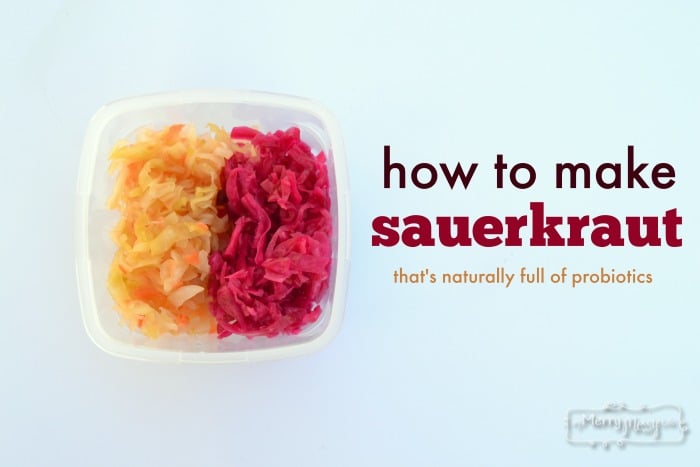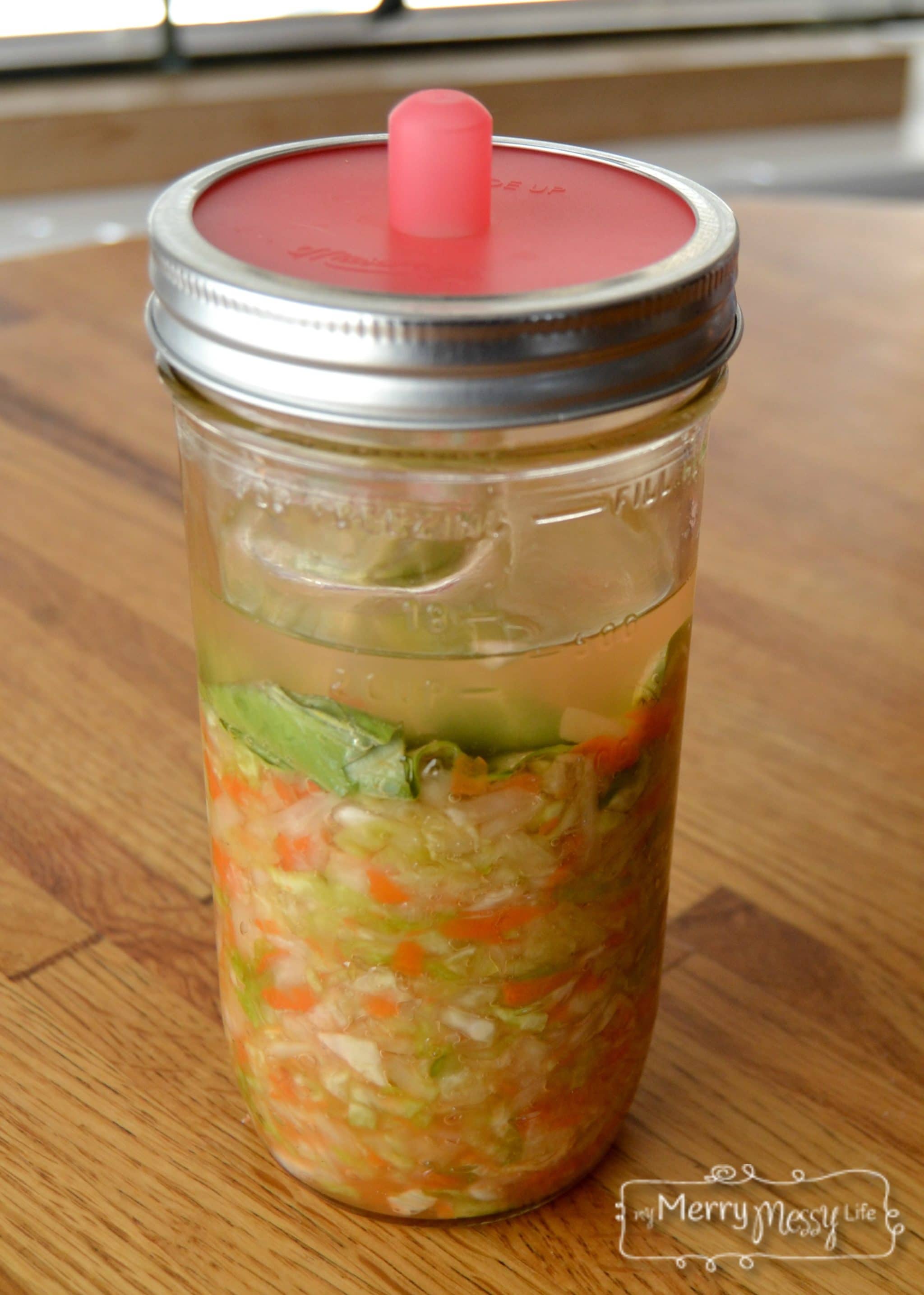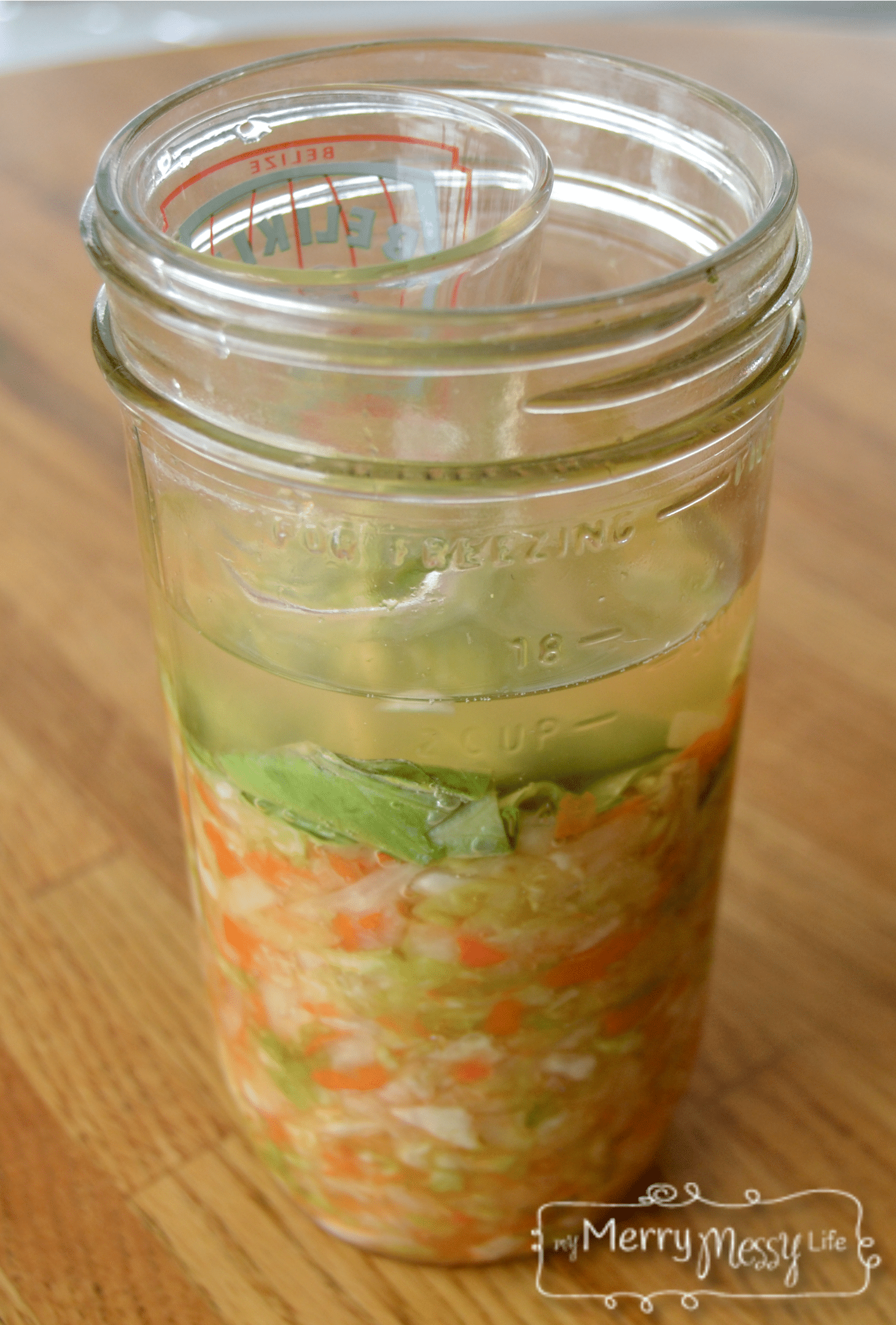Easy Fermented Sauerkraut Recipe – Loaded with Probiotics!
This sauerkraut recipe is tangy, crunchy, full of probiotics and is easy and only pennies to make! Follow along in this tutorial to make your own.

As a kid, the only recollection of sauerkraut I had was when my grandmother would cook a huge batch of it on the stove. And as you can imagine, the entire house would have that “aroma” for the next couple of days. Sauerkraut was salty, mushy, and eaten with a sausage of some kind. Enter…homemade, fermented sauerkraut. Not what my grandmother was cooking up, but something that is fresh, healthy, and full of flavor. It's a great introduction to making your own ferments at home as it's so easy and almost foolproof to make.
Save Your Money on Probiotics!
In the real food community, probiotics are all the rage. We are learning more and more about how having good bugs in your system can aid anything from digestion to a strengthened immune system. Our first instinct is to pop a probiotic pill. And while that is a decent option, real food wins in this case. A serving of fermented sauerkraut offers over ten trillion live probiotics! That means that a 2-ounce serving of fermented sauerkraut has more probiotics than 100 probiotic capsules. THAT IS HUGE, FOLKS! Actual strains and probiotic counts will vary from batch to batch, but that is the beauty of making your own ferments at home. You will continually be introducing numerous new and active probiotic cultures to your body. This can aid in regularity and even help you assimilate more nutrients from the foods you're eating alongside your ferments. Even if you think you don't like sauerkraut, I hope this information is convincing enough for you to give it a try.
What About Store-Bought Sauerkraut?
If making your own sauerkraut isn't something you want to do (come on…it's so easy) or if you're waiting for your next batch to ferment, then you can purchase fermented sauerkraut at the store. It's important that the kraut be refrigerated. You can usually find it in the deli section. And always check the ingredient label. It should be merely cabbage, salt, water, and possible a few spices and other veggies added in. The shelf-stable cans of sauerkraut are made using vinegar and high-heat pasteurization. They may be tasty but have no active cultures. A couple of brands to look for are Bubbies and Farmhouse Culture, although I've seen a few other brands popping up. Ferments are hip, y'all!
Cabbage is Cheap
Cabbage, even organic, is one of the cheapest veggies you can buy at the grocery store. Once you see how simple it is to make yourself, you'll have a hard time paying $7-$10 for the store-bought stuff. The only other ingredient you really need is salt. Use good quality sea salt, not iodized table salt. A quick Google search will yield hundreds of variations on this basic kraut recipe. Once you get the hang of this recipe, feel free to branch out with additional vegetables and spices. The sky is the limit when it comes to ferments!
How to Make It
The basic idea is that you will cut, salt, and pound or squeeze the cabbage until it releases water. This water/salt combo creates the brine, which is what will ferment the cabbage.
Materials:
- Cutting board
- Knife
- Large bowl
- Elbow grease for squeezing or a kraut pounder or a martini muddler (what I use at home).
- 2 16 oz. or 1 32 oz. wide-mouth glass jar. Note: One large cabbage should fit into a one-quart jar.
- Optional: Glass weight (convenient and easy) or an inverted shot glass can also work, as shown in the photos below. This will keep the cabbage below the water level in the jar. Any cabbage that floats above the water level may mold. This is okay, but you'll want to remove it to be safe.
- Optional: Fermentation airlock. I love how easy they are to use; however, they are totally optional. These airlocks allow air to escape the jars. If you don't use one, you'll simply need to release the air yourself every few days by “burping” the jars.

A Few Tips:
- I like to cut the cabbage very thinly. This will make it easier to squeeze the juices out once you've salted them. It also makes for a nice, delicate sauerkraut once it's time to eat.
- Give the salt some time to do its job before you start squeezing or pounding the cabbage. I sprinkle in the salt, stir with my hands to coat, and let it hang out on the counter for an hour or so (more since I get distracted easily). This gives it a head start before you get in to finish the job.
- Pack the jars as tightly as possible. Once you've thoroughly pounded the cabbage and there's plenty of juice/brine, you'll start packing the cabbage into the jar. I like to take a small handful and then use my fist or pounder to press it into the jar. Then add a little more, repeating those steps till the jar is full. Leave a little headroom for your glass weight or an inverted shot glass (see pic below).
- Top your packed cabbage with a large cabbage leaf. Keep a couple of the large, clean outer leaves aside while you work on the kraut. Use a pair of kitchen shears and cut a circle big enough to fit over the cabbage in the jar. This acts as a sort of a lid over the fermenting cabbage. This helps keep the cabbage from floating to the top and possibly molding.
- Add brine if necessary. If your cabbage didn't release enough water/brine to completely cover it once it's packed in the jar, add salt water. Simply dissolve about a teaspoon in one cup of water and add enough to cover the cabbage.
- Taste as you go. Depending on the temperature of your home, cabbage can take anywhere from one to 5(ish) weeks to ferment. The warmer it is, the faster it will ferment. The longer it sits, the tangier it gets. I love my kraut super tangy, and we use air conditioning almost year round. This means that my kraut has to ferment for about a month before it's tangy enough for me.
My son absolutely loves this sauerkraut. I feel so good knowing that he's getting a powerhouse of probiotics with every bite! Let your kids get involved with the process and they will be more likely to enjoy the final product. Squeezing and pounding the cabbage is a great way for them to take out a little aggression on someone other than their baby brother. Or the dog. Or the couch. Or their mother. You get the idea.

Easy Fermented Sauerkraut Recipe – Loaded with Probiotics!
Ingredients
- 1 head of green cabbage
- 1 head of red cabbage
- 1/4 cup salt
- Optional – 1 chopped red onion and 1 chopped bell pepper for added flavor and nutrition
Instructions
- Chop the cabbage into small pieces. Slice it into quarters first to make it easier.
- In a large bowl, combine the chopped cabbage and salt, and mix well.
- Let sit for 30 minutes to an hour to allow the salt to soften the cabbage.
- Pound the cabbage, takes about 10 minutes to get it thoroughly mashed. You’ll know it’s ready when the cabbage is releasing juice.
- Pack the cabbage into the jars as tightly as possible. I like to take a small handful and then using my fist or pounder to press it into the jar. Then add a little more, repeating those steps till the jar is full. Leave a little head room for your glass weight or an inverted shot glass.
- Top your packed cabbage with a large cabbage leaf. Keep a couple of the large, clean outer leaves aside while you work on the kraut. Use a pair of kitchen shears and cut a circle big enough to fit over the cabbage in the jar. This acts as a sort of lid over the fermenting cabbage. This helps keep the cabbage from floating to the top and possible molding.
- If your cabbage didn’t release enough water/brine to completely cover it once it’s packed in the jar, add saltwater. Simply dissolve about a teaspoon in one cup of water and add enough to cover the cabbage.
- Let sit to ferment on your counter for at least 2-3 weeks. Depending on the temperature of your home, cabbage can take anywhere from one to 5(ish) weeks to ferment. The average time is about 2-3 weeks. The warmer it is, the faster it will ferment. The longer it sits, the tangier it gets.
- Eat straight or add it to your hamburgers, hot dogs, sandwiches. Adds such nice tang and crunch!
To Learn More About Homemade Ferments…
Check out my favorite cookbook, Nourishing Traditions. This is a powerhouse of information on how to eat a real, nourishing diet that promotes health and wellness.
Let me know if you give this a try!

Thanks for this recipe….. definitely will start making my own with your recipe guide.. Cheers
You’re welcome!
You’re welcome! Thanks for stopping by!
I made this sauerkraut recipe and wanted to comment how easy it was and how amazing it tastes, thank you! Do I refrigerate it when it is done fermenting?
Lisa
Hi Lisa! So awesome to know it worked so well for you! Thank you for letting me know. Yes, you do refrigerate when it’s done.
What do you use to pound the cabbage?
Hi Cheryl! I’ve used a potato masher before. It works very well!
After three days my batch smell strong is that normal?